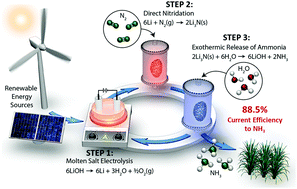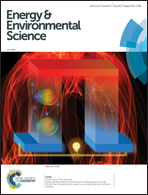Ammonia synthesis from N2 and H2O using a lithium cycling electrification strategy at atmospheric pressure†
Abstract
Ammonia production is imperative to providing food for a growing world population. However, the primary method of synthetic ammonia production, the Haber Bosch process, is resource demanding and unsustainable. Here we report a novel ammonia production strategy, exemplified in an electrochemical lithium cycling process, which provides a pathway to sustainable ammonia synthesis via the ability to directly couple to renewable sources of electricity and can facilitate localized production. Whereas traditional aqueous electrochemical approaches are typically dominated by the hydrogen evolution reaction (HER), we are able to circumvent the HER by using a stepwise approach which separates the reduction of N2 from subsequent protonation to NH3, thus our synthesis method is predominantly selective for ammonia production. Density functional theory calculations for thermodynamic and diffusion energy barrier insights suggest that Li-based materials are well suited to carry out this process, though other materials may also be useful. The three steps of the demonstrated process are LiOH electrolysis, direct nitridation of Li, and the exothermic release of ammonia from Li3N, which reproduces the LiOH, completing the cycle. The process uses N2 and H2O at atmospheric pressure and reasonable temperatures, and, while approaching industrial level electrolytic current densities, we report an initial current efficiency of 88.5% toward ammonia production.

- This article is part of the themed collection: 2017 Energy and Environmental Science HOT articles


 Please wait while we load your content...
Please wait while we load your content...